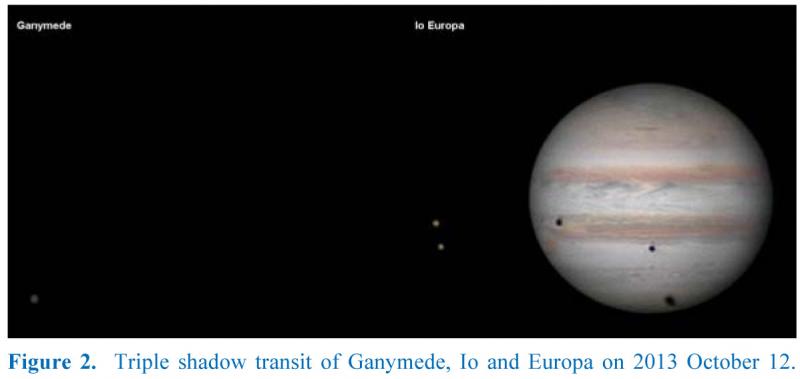High resolution imaging of mutual events of the Jovian satellites during the 2014/2015 apparition
2016 September 24
During the 2014/2015 Jupiter apparition several mutual occultations and eclipses of the Galilean satellites took place. These mutual events occur every 5.93 years. A number of the events were recorded using 14-inch [355mm] or larger telescopes and different types of cameras. Processing programs like Registax 6.1 or Autostakkert2! struggle to grade, align and stack the tiny images of the Jovian satellites. To obtain high resolution images different processing procedures were employed to optimise the quality of the images, including hand selection and the use of master frames. Several occultations and eclipses were recorded at high resolution. In several eclipses the umbra and penumbra could be successfully distinguished. An interesting phenomenon was observed near the date of opposition, viz. the simultaneous occultation and eclipse of Ganymede by Callisto on 2015 February 7, one day after opposition.
Introduction Jupiter is a favourite object for planetary observers. Even with small telescopes many details can be seen on this giant among the planets, such as the dark North and South Equatorial Belts, many minor atmospheric features and, of course, the famous Great Red Spot. Another interesting feature of the Jovian system is the perpetual dance of the four large satellites Io, Europa, Ganymede and Callisto. From time to time transits of the satellites and their shadows over the globe of Jupiter can be observed (Figures 1 and 2). These phenomena make the Jovian system one of the most fascinating in the solar system.
Jupiter is a favourite object for planetary observers. Even with small telescopes many details can be seen on this giant among the planets, such as the dark North and South Equatorial Belts, many minor atmospheric features and, of course, the famous Great Red Spot. Another interesting feature of the Jovian system is the perpetual dance of the four large satellites Io, Europa, Ganymede and Callisto. From time to time transits of the satellites and their shadows over the globe of Jupiter can be observed (Figures 1 and 2). These phenomena make the Jovian system one of the most fascinating in the solar system.
Jupiter rotates around the Sun in nearly 12 Earth-years. Every 5.93 years the Sun and Earth pass through the Jovian equatorial plane (Figure 3). This causes some phenomena of particular interest, viz. mutual occultations and eclipses of the big Jovian satellites.
The Institut de Mécanique Céleste et de Calcul des Ephémérides (ICCME) has through the years collected observational data about these events. The emphasis was on the photometric aspects. In recent years with the development of digital astrophotography, amateurs such as Damian Peach, Christopher Go, Leo Aerts & Willem Kivits have successfully detected details on the tiny disks of the Galilean moons (see for instance the website of the ALPO Japan). Marc Delcroix has posted a collection of resolved videos of these events from various observers. Observations and photometry of these events have been used to check the orbits of the satellites.
The most recent period that mutual events occurred was in 2014/2015. From the Netherlands Jupiter stood high in the sky and moved through Leo and Cancer. This was very favourable for imaging the events. The next opportunity will be in 2021. This passage will be rather unfavourable for us living in the Netherlands and the UK, because then Jupiter is low above the horizon in Capricorn and Sagittarius…. (continued…)
(Login or click above to view the full article in PDF format)
| The British Astronomical Association supports amateur astronomers around the UK and the rest of the world. Find out more about the BAA or join us. |
